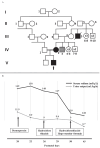Diagnostic Pitfalls of a Newborn with Congenital Nephrogenic Diabetes Insipidus
- PMID: 36815512
- PMCID: PMC11923502
- DOI: 10.4274/jcrpe.galenos.2023.2022-11-22
Diagnostic Pitfalls of a Newborn with Congenital Nephrogenic Diabetes Insipidus
Abstract
Congenital nephrogenic diabetes insipidus (NDI) is a rare cause of hypernatremia in newborns. Central diabetes insipidus (CDI) is the main differential diagnosis in NDI, however NDI responds poorly to desmopressin acetate (DDAVP) treatment, while this is the mainstay of CDI management. Therefore, early and correct diagnosis of NDI is important to avoid the complications of inappropriate therapy. We report a newborn with hypernatremia and hypotonic polyuria. The patient was initially responsive but subsequently unresponsive to intranasal DDAVP treatment in terms of both urine output and serum sodium levels. A novel hemizygous missense mutation (c.632T>C, p.L211P) in the AVPR2 gene was found in both the baby and his mother, and the diagnosis of congenital NDI was established. After hydrochlorothiazide treatment and hypo-osmolar formula were given, urine volume was decreased, and serum sodium levels were normalized. Early recognition and appropriate management of NDI may prevent complications of hypernatremic dehydration in young infants.
Keywords: AVPR2; Nephrogenic diabetes insipidus; hypernatremia; neonate.
©Copyright 2025 by Turkish Society for Pediatric Endocrinology and Diabetes / The Journal of Clinical Research in Pediatric Endocrinology published by Galenos Publishing House.
Conflict of interest statement
Conflict of interest: None declared.
Figures


Similar articles
-
Case Report of Nephrogenic Diabetes Insipidus with a Novel Mutation in the AQP2 Gene.Int J Mol Sci. 2025 Aug 1;26(15):7415. doi: 10.3390/ijms26157415. Int J Mol Sci. 2025. PMID: 40806548 Free PMC article.
-
The natural history of untreated X-linked nephrogenic diabetes insipidus with mutation in the vasopressin V2 receptor gene.CEN Case Rep. 2025 Jun;14(3):306-311. doi: 10.1007/s13730-024-00954-3. Epub 2024 Dec 7. CEN Case Rep. 2025. PMID: 39644399 Free PMC article.
-
A case of a novel mutant vasopressin receptor-dependent nephrogenic diabetes insipidus with bilateral non-obstructive hydronephrosis in a middle aged man: differentiation from aquaporin-dependent nephrogenic diabetes insipidus by response of factor VII and von Willebrand factor to 1-diamino-8-arginine vasopressin administration.Endocr J. 2003 Dec;50(6):809-14. doi: 10.1507/endocrj.50.809. Endocr J. 2003. PMID: 14709855
-
Identification and characterization of a novel X-linked AVPR2 mutation causing partial nephrogenic diabetes insipidus: a case report and review of the literature.Metabolism. 2012 Jul;61(7):922-30. doi: 10.1016/j.metabol.2012.01.005. Epub 2012 Mar 3. Metabolism. 2012. PMID: 22386940 Review.
-
Genetic forms of nephrogenic diabetes insipidus (NDI): Vasopressin receptor defect (X-linked) and aquaporin defect (autosomal recessive and dominant).Best Pract Res Clin Endocrinol Metab. 2016 Mar;30(2):263-76. doi: 10.1016/j.beem.2016.02.010. Epub 2016 Mar 2. Best Pract Res Clin Endocrinol Metab. 2016. PMID: 27156763 Review.
References
-
- Sahakitrungruang T, Tee MK, Rattanachartnarong N, Shotelersuk V, Suphapeetiporn K, Miller WL. Functional characterization of vasopressin receptor 2 mutations causing partial and complete congenital nephrogenic diabetes insipidus in Thai families. Horm Res Paediatr. 2010;73(5):349–354. doi: 10.1159/000308167. - DOI - PubMed
Publication types
MeSH terms
Substances
LinkOut - more resources
Full Text Sources
